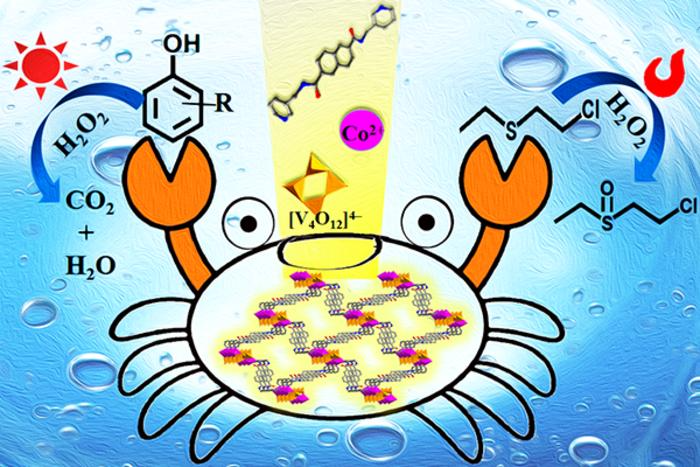A group of scientists from Bohai University in China have created and developed a bifunctional catalyst that could tackle the environmental pollution caused by phenolic compounds and mustard gas. They used hydrothermal conditions to create this bifunctional catalyst, a novel metal-organic framework based on polyoxovanadate in three dimensions.
 Researchers have developed a new three-dimensional 2-fold interpenetrating polyoxovanadate-based metal-organic framework that shows satisfying catalytic performances for the selective oxidation of 2-chloroethyl ethyl sulfide (CEES) to corresponding sulfoxide (CEESO) and photodegradation toward phenol, 2-chlorophenol and m-cresol under visible light. Image Credit: Polyoxometalates, Tsinghua University Press
Researchers have developed a new three-dimensional 2-fold interpenetrating polyoxovanadate-based metal-organic framework that shows satisfying catalytic performances for the selective oxidation of 2-chloroethyl ethyl sulfide (CEES) to corresponding sulfoxide (CEESO) and photodegradation toward phenol, 2-chlorophenol and m-cresol under visible light. Image Credit: Polyoxometalates, Tsinghua University Press
On March 4th, 2024, their study was published in the journal Polyoxometalates.
The selective oxidation of 2-chloroethyl ethyl sulfide (CEES) to corresponding sulfoxide (CEESO) and photodegradation toward phenol, CEES, and m-cresol under visible light exhibit satisfactory catalytic performances for the team’s bifunctional catalyst. A catalyst that performs both basic and acidic catalysis is known as a bifunctional catalyst.
The issue of organic toxic substances contributing to pollution has garnered significant attention recently. The goal of scientists’ efforts has been to create practical processes for breaking down these organic hazardous substances. Mustard gas, also known as CEES, is a chemical warfare weapon that can be fatal and cause serious skin conditions as well as intense respiratory tract irritation.
Researchers have been looking for ways to detoxify mustard gas ever since it was first used in World War I. An organic compound called m-cresol is taken out of coal tar and utilized to make other compounds, such as insecticides. It is corrosive to the respiratory system, skin, and eyes.
Water that is contaminated by industrial, agricultural, and residential activities frequently contains phenolic contaminants. Phenolic pollutants can be extremely hazardous to humans and the environment if they enter water systems. Animals, birds, or fish could perish as a result of these pollutants’ acute toxicity. Plant development might be hindered or even killed by them.
Researchers have been trying to create novel bifunctional catalysts through synthesis that can change these harmful pollutants into degradants with minimal toxicity. Nevertheless, scientists have not yet effectively prepared high-dimensional interpenetrating metal-organic frameworks that can operate as bifunctional catalysts capable of degrading phenolic compounds under visible light and oxidizing CEES to CEESO.
Inorganic metal oxide clusters known as polyoxometalates (POMs) have a variety of architectural configurations and alluring characteristics. Their diverse range of forms and functions makes them one of the most valuable groups of inorganic molecular materials. Scientists have been studying polyoxovanadates (POVs), a subfamily of POMs, more and more because of their unique structures and intriguing characteristics.
The novel metal-organic framework based on POV was constructed by the researchers using a bis-pyridyl-bis-amide ligand. Next, they used powder X-Ray diffraction, IR spectroscopy, and single crystal X-Ray diffraction research to investigate the 3D POV-based metal-organic framework.
The long feature of the amide-based ligand induces the formation of the unusual 2-fold interpenetrating structure.
Guo-Cheng Liu, Associate Professor, Bohai University
The bifunctional catalyst developed by the researchers effectively facilitated the selective oxidation of hazardous CEES to a safer sulfoxide when hydrogen peroxide (H2O2) was present, an environmentally benign oxidant. It operated with good stability and recyclability in the presence of light. Selectivity was 97% and the successful conversion rate was 99 percent.
Furthermore, under visible light, the bifunctional catalyst exhibited high photocatalytic degradation activity toward phenol, CEES, and m-cresol. For 140 minutes, the team was able to attain degradation efficiencies greater than 92.6 percent. They also thoroughly examined the processes of photodegradation, the kinetics of photocatalytic reactions, and the potential for phenol recycling.
Liu added, “This work provides important guidance for the development of new POVs-based bifunctional catalysts for the decontamination in water.”
Shuang Li, Yuan Zheng, Guo-Cheng Liu, Xiao-Hui Li, Zhong Zhang, and Xiu-Li Wang from the Liaoning Professional Technology Innovation Center of Liaoning Province for Conversion Materials of Solar Cell, College of Chemistry and Materials Engineering, Bohai University, China constituted the research team.
National Natural Science Foundation of China and the Natural Science Foundation and Education Department of Liaoning Province funded the study.
Journal Reference:
Li, S., et. al. (2024) New two fold interpenetrating 3D polyoxovanadate-based metal–organic framework as bifunctional catalyst for the removal of 2-chloroethyl ethyl sulfide and phenolic compounds. Polyoxometalates. doi:10.26599/POM.2024.9140061.